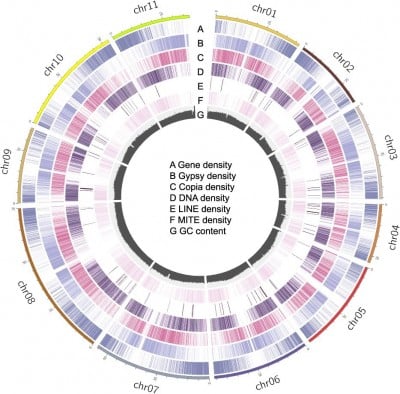Science
Researchers Unveil First Complete Mung Bean Genome for Breeding Advances

A collaborative team of researchers has successfully sequenced the first complete telomere-to-telomere (T2T) genome of the mung bean, known scientifically as Vigna radiata. This groundbreaking achievement reveals important insights into how structural variations in the plant’s genome have influenced its domestication and adaptation over time.
Utilizing a combination of advanced sequencing technologies, including PacBio HiFi, Oxford Nanopore, and Hi-C sequencing, the study identified critical genetic changes linked to various traits such as plant architecture, stress response, and metabolic pathways. The research highlights the significant role of transposable element amplification, which has reshaped gene expression in nearby areas, enhancing our understanding of how these elements contribute to plant development.
Insights into Genetic Adaptations
The comprehensive genome analysis has unveiled that genes involved in fatty acid synthesis, suberin formation, and phenylpropanoid metabolism have undergone strong selection pressures throughout the mung bean’s evolutionary history. These findings provide valuable insights into the genetic adaptations that have allowed mung beans to thrive in diverse environments.
The implications of this research extend beyond academic curiosity. By elucidating the genetic basis of important traits, the genome serves as a pivotal resource for guiding molecular breeding efforts aimed at improving yield and resilience in mung bean cultivars. As global demand for sustainable food sources rises, the ability to breed more productive and resilient crops becomes increasingly vital.
Future Directions for Breeding Initiatives
This comprehensive genome study not only contributes to the scientific community’s understanding of mung bean evolution but also lays the groundwork for potential advancements in agricultural practices. Improved breeding strategies informed by this genomic data could lead to higher yields and better adaptability of mung beans to changing climate conditions.
In conclusion, the successful generation of the first gap-free genome of Vigna radiata marks a significant milestone in plant genomics. The findings underscore the importance of structural variations in the evolution of this crucial crop and highlight the potential for future research to further enhance food security through innovative breeding techniques.
-

 Politics2 weeks ago
Politics2 weeks agoDallin H. Oaks Assumes Leadership of Latter-day Saints Church
-

 Sports2 weeks ago
Sports2 weeks agoSteve Kerr Supports Jonathan Kuminga After Ejection in Preseason Game
-

 Entertainment2 weeks ago
Entertainment2 weeks agoZoe Saldana Advocates for James Cameron’s Avatar Documentary
-

 Business2 weeks ago
Business2 weeks agoTyler Technologies Set to Reveal Q3 2025 Earnings on October 22
-

 Science2 weeks ago
Science2 weeks agoChicago’s Viral ‘Rat Hole’ Likely Created by Squirrel, Study Reveals
-

 Lifestyle2 weeks ago
Lifestyle2 weeks agoKelsea Ballerini Launches ‘Burn the Baggage’ Candle with Ranger Station
-

 Lifestyle2 weeks ago
Lifestyle2 weeks agoDua Lipa Celebrates Passing GCSE Spanish During World Tour
-

 Health2 weeks ago
Health2 weeks agoRichard Feldman Urges Ban on Menthol in Cigarettes and Vapes
-

 World2 weeks ago
World2 weeks agoD’Angelo, Iconic R&B Singer, Dies at 51 After Cancer Battle
-

 Business2 weeks ago
Business2 weeks agoMLB Qualifying Offer Jumps to $22.02 Million for 2024
-

 Sports2 weeks ago
Sports2 weeks agoPatriots Dominate Picks as Raiders Fall in Season Opener
-

 Health2 weeks ago
Health2 weeks agoCommunity Unites for Seventh Annual Mental Health Awareness Walk








